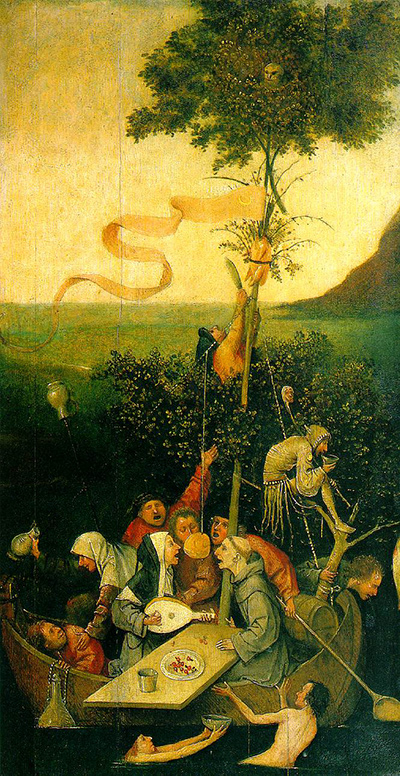This fascinating image entitled "The Ship of Fools" was originally part of a triptych or 3 panels, which were painted in oil and date from around 1490 to 1500.
This incomplete section of the panel is now kept in the Louvre. The two other sections show an "Allegory of Gluttony" and "Death and the Miser".
The wood on which the panel has been painted with a limited, yet rich selection of colours, including lead-tin yellow, red lake and lead white, has been dated to around 1491. It is believed that Bosch's Ship of Fools was inspired by the allegory written by Sebastian Brant in 1494.
The illustration shows ten people adrift in a boat, two others overboard. In the centre of the group is a nun playing a lute and a friar. To the left of the image, a woman appears to be about to hit a man who is dragging a flagon in the water.
To the right of the picture another man appears to be vomiting over the side. Above him, a man clearly dressed as a fool, is drinking from a cup. One of the boatmen is using a huge ladle instead of an oar, the other has a flagon on the end of his oar.
Dangling from the mast is a pancake, or similar item, which the main group might be trying to eat. This may be a reference to a traditional folk custom or game. Climbing up the mast is another character who is about to carve some meat from a roasted bird strapped to the mast.
The mast itself is tree-like and covered in flowers and leaves. From the mast flies a flag bearing a crescent moon, perhaps a symbol of "lunacy" derived from the Latin word "luna". High in the mast's foliage sits an owl, which appears almost skull like at first glance. The owl, in mediaeval times was a symbol of bad luck.
The overall image is of a group of fools adrift in the sea of life, eating and drinking to excess. They are without morals and rudderless despite the church being on board. They all are lacking direction in life and oblivious to the men overboard.
This wonderful painting is one of Bosch's powerful and poignant images. A social commentary of life as he saw it, many centuries ago.




